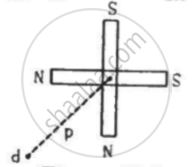Advertisements
Advertisements
प्रश्न
A monoenergetic (18 keV) electron beam initially in the horizontal direction is subjected to a horizontal magnetic field of 0.04 G normal to the initial direction. Estimate the up or down deflection of the beam over a distance of 30 cm (me = 9.11 × 10–31 kg).
उत्तर
Energy of an electron beam, E = 18 keV = 18 × 103 eV
Charge on an electron, e = 1.6 × 10−19 C
E = 18 × 103 × 1.6 × 10−19 J
Magnetic field, B = 0.04 G
Mass of an electron, me = 9.11 × 10−19 kg
Distance up to which the electron beam travels, d = 30 cm = 0.3 m
We can write the kinetic energy of the electron beam as:
E = `1/2 "mv"^2`
v = `sqrt((2"E")/"m")`
= `sqrt((2 xx 18 xx 10^3 xx 1.6 xx 10^-19 xx 10^-15)/(9.11 xx 10^-31))`
= 0.795 × 108 m/s
The electron beam deflects along a circular path of radius, r.
The force due to the magnetic field balances the centripetal force of the path.
BeV = `"mv"^2/"r"`
∴ r = `"mv"/"Be"`
= `(9.11 xx 10^-31 xx 0.795 xx 10^8)/(0.4 xx 10^-4 xx 1.6 xx 10^-19)`
= 11.3 m
Let the up and down deflection of the electron beam be x = r(1 − cos θ)
Where,
θ = Angle of declination
sin θ = `"d"/"r"`
= `0.3/11.3`
θ = `sin^-1 0.3/11.3` = 1.521°
And x = 11.3(1 − cos 1.521°)
= 0.0039 m
= 3.9 mm
Therefore, the up and down deflection of the beam is 3.9 mm.
APPEARS IN
संबंधित प्रश्न
Show that the orbital magnetic dipole moment of a revolving electron is `(eVr)/2`
An electron in an atom revolves around the nucleus in an orbit of radius 0.53 Å. If the frequency of revolution of an electron is 9 x109 MHz, calculate the orbital angular momentum
[Given : Charge on an electron = 1.6 x 10–19 C; Gyromagnetic ratio = 8.8 x 1010 C/kg; π = 3.142]
The electron in the hydrogen atom is moving with a speed of 2.3x106 m/s in an orbit of radius 0.53 Å. Calculate the period of revolution of the electron. (Π = 3.142)
Do two distinct poles actually exist at two nearby points in a magnetic dipole?
When a current in a circular loop is equivalently replaced by a magnetic dipole,
Let r be the distance of a point on the axis of a magnetic dipole from its centre. The magnetic field at such a point is proportional to
Two short magnets of equal dipole moments M are fastened perpendicularly at their centre in the Figure . The magnitude of the magnetic field at a distance d from the centre on the bisector of the right angle is

A magnetic dipole of magnetic moment 0.72 A m2 is placed horizontally with the north pole pointing towards south. Find the position of the neutral point if the horizontal component of the earth's magnetic field is 18 μT.
The magnetic moment vectors µs and µl associated with the intrinsic spin angular momentum S and orbital angular momentum l, respectively, of an electron are predicted by quantum theory (and verified experimentally to a high accuracy) to be given by:
µs = –(e/m) S,
µl = –(e/2m) l
Which of these relations is in accordance with the result expected classically? Outline the derivation of the classical result.
